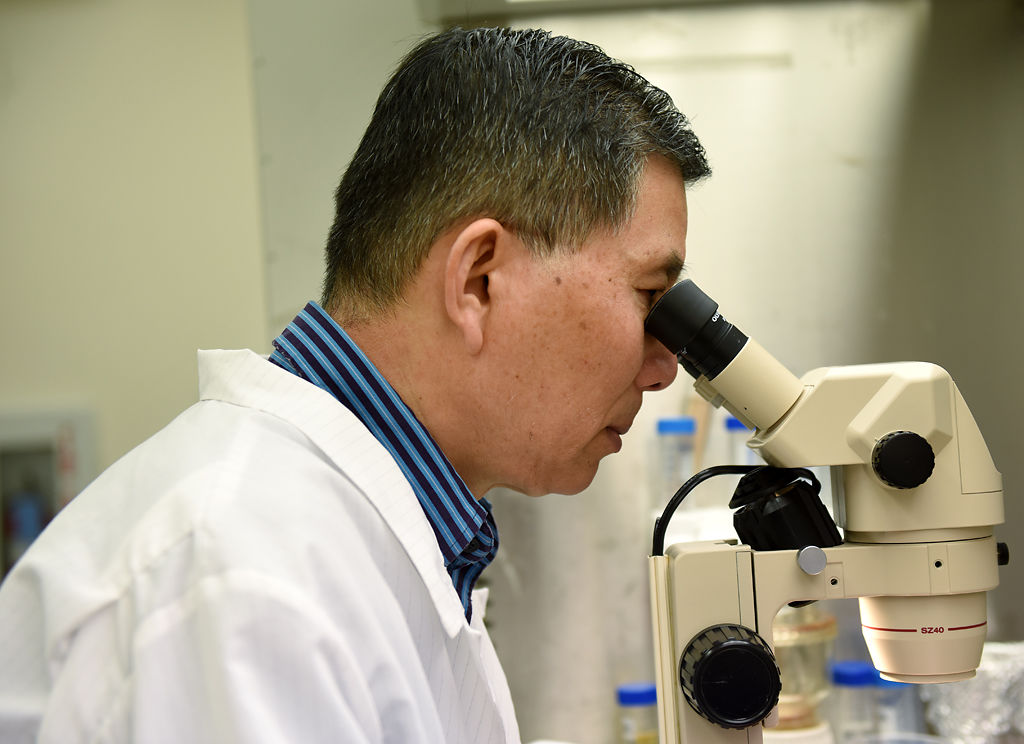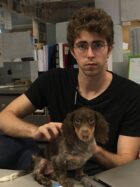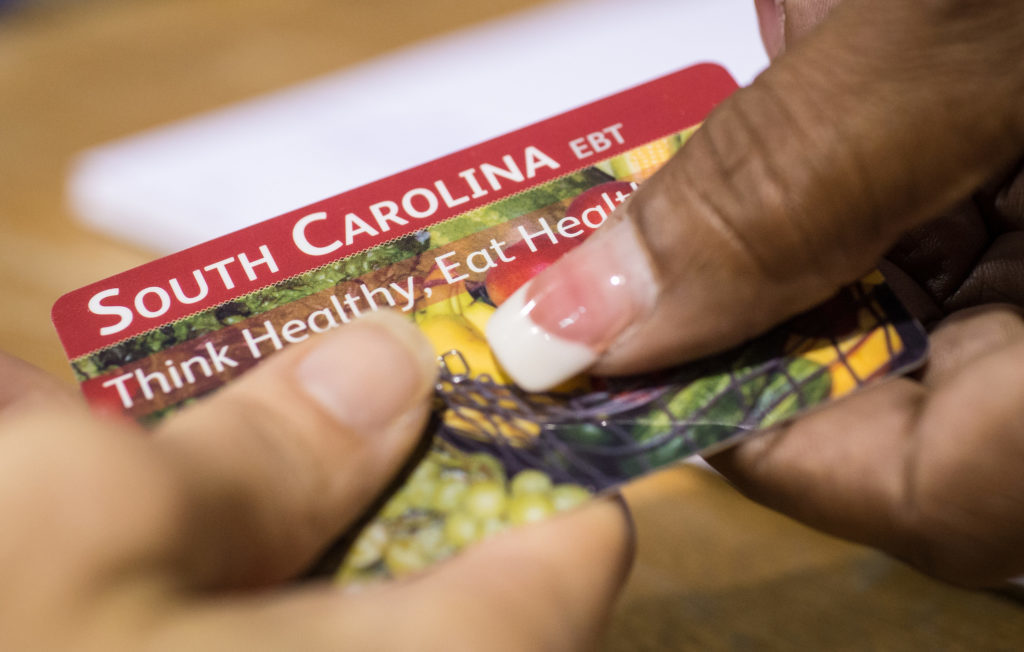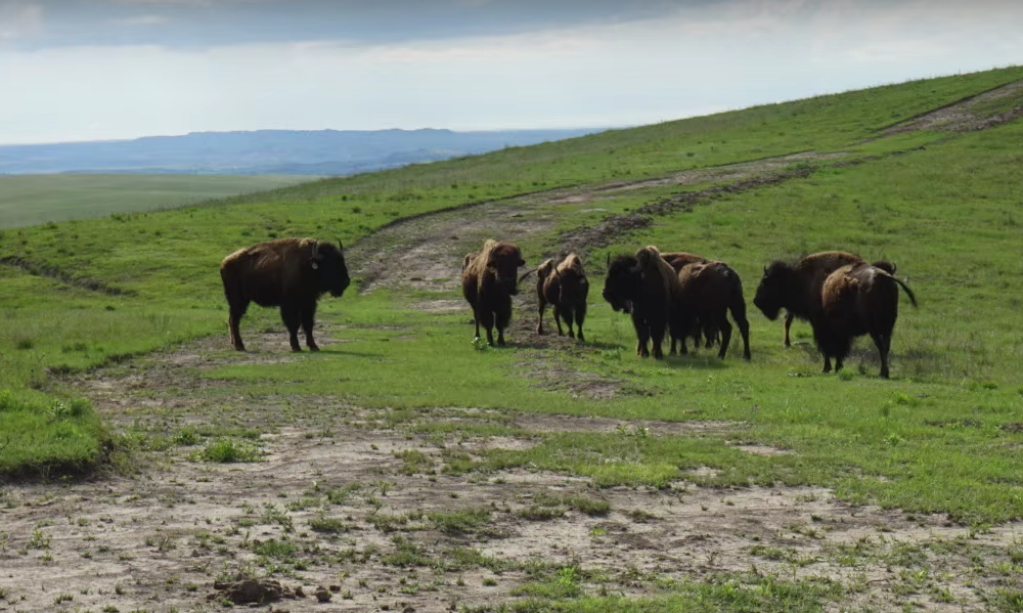
Jason Vance/Columbia Missourian
In 2006, Zhanyuan Zhang, a University of Missouri professor of plant sciences, was approached by Dow AgroSciences. The industry giant came bearing pieces of DNA and a problem for Zhang to solve.
Industrial agriculture faced a new wave of herbicide-resistant weeds in fields worldwide, which threatened to make Roundup — the most popular weedkiller among farmers — useless. Dow wanted to create a new strain of soybeans that could tolerate a different herbicide. Because Zhang is an expert in transforming plant genetics, the company tapped him to help.
“They want to hit the market as quickly as possible,” Zhang said. “And they found my lab as a collaborator.”
The public-private collaboration was a success on both sides.
Dow patented the results of the research and used them to develop a slew of new weed-control products, valued at over $1 billion. Meanwhile, Zhang got a multimillion dollar grant, a co-published paper in a prestigious journal and further contracts with Dow.
The partnership is emblematic of the broader system of industry-sponsored research that takes place in MU’s College of Agriculture, Food and Natural Resources (CAFNR), and especially in the Division of Plant Sciences. Corporate money goes to MU professors on both ends of the research spectrum, from basic science to product testing.
Industry’s stake in the system is clear. Companies gain the expertise and credibility of renowned plant science experts like Zhang and MU Extension experts who Missouri farmers trust.
What’s not so clear is how the public benefits.
Agricultural companies build relationships with professors and extension personnel so they can learn what farmers need — and thus drive sales. Even some MU professors who take the money point out that companies give in order to benefit their own bottom line.
Critics say such funding cultivates a culture of influence that tends to bend research toward company goals. This has been well-documented in fields such as medicine, where drug companies often pay physicians who promote their products.
MU and many other public universities believe that researchers should work closely with companies. They explicitly encourage professors to build relationships with private corporations, arguing that these can enrich research and teaching, and that society benefits when intellectual property is commercialized.
But some MU experts play a dual role: They take industry money to evaluate its products, while also providing information about those products to farmers.
Such conflicts of interest have gotten less scrutiny in agricultural research, where the potential consequences are wide-ranging. Soybeans and corn are used in a vast number of ways: They feed people and livestock; they are found in lotions, soaps and cleaning supplies; they are the basis of biofuels. The pesticides studied by MU researchers blanket fields worldwide.
One thing is evident: Industry money will continue to have a key place in the university’s funding landscape. MU wants to radically increase its external funding levels in the next few years. And in an era when federal funding is flat and competition for such grants is fierce, where else will researchers go for funds?
Plant Sciences stand out
The fact that researchers in MU’s Division of Plant Sciences receive research money from industry isn’t unexpected.
The division houses researchers in fields such as entomology, agronomy and plant pathology. Its faculty members’ research areas — which include agricultural production, pest management and plant breeding — that intersect with industry interests. MU has a reputation for excellent agricultural programs in general and, because the university is nestled in farm country, agribusiness is always nearby; St. Louis-based Monsanto is practically a local company.
But the amount of industry funding the division receives stands out when compared to other CAFNR departments, according to a Missourian analysis of funding data from fiscal year 2009 to 2018. Download PDF

Plant Sciences received about 13.8% of its external funding directly from industry sources, including agrochemical and seed companies Monsanto, Dow AgroSciences and Syngenta. That translates to $13 million of the department’s $94 million, a total that includes funding for Plant Science’s extension programs.
While the School of Natural Resources brought in almost as many total dollars, it received a negligible proportion of corporate money — less than 1%. That’s similar to other departments in CAFNR, including Food Systems & Bioengineering and Applied Social Science.
After Plant Sciences, the next largest recipient of corporate money was the Division of Animal Sciences, but it got only 6.7% of its external funding from industry sources.
Plant Sciences is also an outlier among departments across campus.
Among the 18 departments that brought in $40 million or more from industry sources, the Department of Medicine was the only one that had a higher percentage from corporate sources, at 22.4%. There are other departments — including many in the School of Medicine — that bring in higher proportions, though they all bring in significantly less total funding.
Shibu Jose, interim associate dean in CAFNR’s office of research and extension, said in an emailed statement that CAFNR’s largest contributors are federal research agencies. These include the USDA’s National Institute of Food and Agriculture, the National Institutes of Health and the National Science Foundation.
CAFNR’s website features a graphic stating that 58% of its research expenditures in 2017 were federal.
But a closer comparison reveals a more complex story.
Only 40.3% of Plant Science’s external funding for fiscal years 2009 to 2018 was federal in origin, according to the Missourian’s data analysis. This was far less than its sister departments, Animal Science at 83.9% and Natural Resources at 77.4%.
“Funding sources that are needed and available to support research of specific arenas vary,” Jose wrote.
Researchers pursue funding based on their interests, and it’s to be expected that the research portfolio of Plant Sciences will differ from that of other departments, Jose wrote. Download PDF
 But plant sciences, as a scientific field, is not uniquely tied to industry.
But plant sciences, as a scientific field, is not uniquely tied to industry.
While researchers at MU’s School of Natural Resources receive almost no corporate money, the field overlaps with industry interests, including those of fossil fuel companies. For example, ExxonMobil and other companies have given millions in research funding to the Warner College of Natural Resources at Colorado State University, according to High Country News.
Plant Sciences is “one of the very top research groups in the nation, and as such, would be expected to attract more funding from all sources, including industry organizations,” Jose wrote.
His answer did not specifically address the differing percentages.
It’s not just industry money that compensates for Plant Sciences’ lower levels of federal funding, though. Plant Sciences also pulls in proportionately more grant funding from nonprofit industry organizations, foundations and other universities. Some of these organizations are directly tied to industry.
For example, the division received over $13 million from the Missouri Soybean Merchandising Council — the most from any single funder. The council is a non-profit checkoff organization, which collects fees from soybean producers to fund research and advertising to promote the industry. Download PDF

From a $2.6 million grant to a $1 billion product
Within CAFNR, researchers’ funding portfolios vary widely.
Of the 280-plus CAFNR researchers — including those in extension — who secured external funding, 210 didn’t receive any industry money, according to the Missourian’s analysis. Of those who did, only 11 got more than $500,000. Eight were in Plant Sciences. Four Plant Sciences professors and one Animal Sciences professor each brought in over $1 million.
Zhang, the professor of Plant Sciences, brought in the most by far. About $4 million of his $5.7 million total funding came from industry.
Zhang’s Plant Biotechnology Innovation Laboratory collaborates with both public organizations and private companies. But while the research his lab does for a sponsor is very similar, the goal in each case is different, Zhang said.
For the companies the goal is profit, he said, “but the public (research) is just for the discovery — for the scientific discovery.”
When Zhang began his collaborations with the agrochemical company then-known as Dow AgroSciences, its main goal was to develop a new product: a herbicide-resistant soybean.
For years, farmers have sprayed the herbicide glyphosate — commonly sold under the brand-name Roundup — on crops that have been genetically altered to survive the weedkiller. Monsanto pioneered the system in the mid-1990s, and it has been efficient for farmers and immensely profitable for industry.
In recent decades, though, there has been a spike in glyphosate-resistant weeds caused by overuse of the herbicide.
One of Dow’s solutions was to combine glyphosate with 2,4-D, which is another herbicide, and develop a soybean resistant to both.
Dow had a gene it thought would work, but at the time, it had no way of putting it into a soybean seed to find out for sure. It could do the work in other crops, like corn, but engineering new soybeans is tricky.
That’s where Zhang and his lab came in.
His lab successfully engineered and tested a soybean that was resistant to 2,4-D. Dow provided $2.6 million in grants and used the results to help develop its herbicide-seed combo, marketed as the Enlist weed control system.
Zhang and his collaborators shared the results of the work in a 2010 paper, though Dow had already taken steps to secure its ownership of the key genes. The company filed to patent them in 2006.
The U.S. Department of Agriculture approved the commercial planting of the soybeans (and 2,4-D-resistant corn) in 2014, although actual sales of the new herbicide didn’t begin until 2015. Dow’s head of research and development told Reuters that Enlist was “the most important release we’ve had.”
Dow estimated Enlist’s value to the company would be over $1 billion.
‘Absolutely critical’ to industry profits
In Pengyin Chen’s decades of experience in the soybean world, he’s never been much impressed by industry’s generosity.
“Companies don’t give us a penny,” Chen said. “They benefit from our research. A company’s goal is to make money, not to give money away.”
Chen is the David M. Haggard Endowed Professor of Soybean Breeding at MU, and he has headed the Fisher Delta Research Center’s soybean breeding program since 2016. Before that, he was at the University of Arkansas, and his work has spanned the research spectrum, from developing new breeds of soybean to doing service orders.
University research on dicamba, which received scrutiny because of the widespread crop damage it caused in recent years, was funded by service orders.
But the companies he’s worked with aren’t interested in investing in basic science, Chen said, adding that there’s really no such thing as “company-sponsored research.”
“Anything we release, they can make use of,” he said. “It’s kind of a second step, taking what we find to benefit their commercial pipelines.”
Why does a massive company need to collaborate with MU to fill its product pipelines?
After all, before Bayer acquired Monsanto in 2018, the two companies announced that they planned to spend $16 billion on research and development over the next six years. The combined $4 million that the companies spent on research at MU over the 10 years examined by the Missourian seems minuscule by comparison.
It’s impossible to generalize about what companies might need from a university, said Steven Padgette, a managing director at the private equity firm Paine Schwartz.
Padgette was formerly the vice president of R&D investment strategy at Monsanto, where he worked from 1984 to 2016.
 Jason Vance/Columbia Missourian
Jason Vance/Columbia Missourian Grain sorghum sprouts from tiny tissue cultures on Dec. 4, 2018, at MU’s Sears Plant Growth Facility. Zhanyuan Zhang is working to advance transgenic technology’s applications in the field of agriculture.
Padgette said a large company would usually turn to universities and their extension programs when it needs to understand exactly how a product might work for a customer. It’s about harnessing on-the-ground expertise.
“The weed science departments, the extension services, the entomology departments, agronomy departments — those professors in those types of departments are absolutely critical for the product development because they are very knowledgeable about what the farmers’ problems are and what solutions might be,” he said.
That role as an aid to Missouri farmers and an ear to their practical problems is one MU Extension prides itself on.
Because the university serves the people of Missouri, it’s the most unbiased source of information, said Lee Miller, an MU Plant Sciences professor who works in both research and extension.
“We’re not tied to anybody,” he said. “We’re here to solve problems and to answer questions, and to try and improve society — that’s what we’re here for.”
A culture of industry influence
At the heart of this relationship is a potential conflict.
MU researchers who have studied a product are clearly qualified to talk about it. And if a new bioengineered seed or herbicide can solve a problem, it makes sense for them to recommend it.
The fact that researchers at public universities take money from agricultural companies to study their products — and then make recommendations about those products — has been heavily criticized. The financial relationship, critics argue, aligns with industry’s commercial interests and encourages the overuse of industrial farming methods such as pesticides.
There are multiple ways that industry money can influence agricultural research at a land grant university, said John Ikerd, MU professor emeritus of agricultural economics. He retired from MU in 2000 and was also a state co-coordinator for sustainable agriculture extension programs in Missouri from 1995 to 2000.
Apart from obvious things such as gifts to the university, companies often cultivate relationships with particular professors, Ikerd said.
Researchers might get grants for projects of interest to a corporation, Ikerd said. If the results are favorable to a corporation’s interests, a researcher will likely get more funding when he or she needs it for a particular project.
“Once you acclimate a professor to a research partnership it’s going to alter their perceptions and what they say about those companies,” he said.
But even if you don’t wish to accept industry money, you have to tread carefully, Ikerd said.
“Industry creates a culture in which it can be very hard to resist their influence,” he said.
One way that industry shapes research is simply by selecting the type of work that gets done in the first place.
The thing about industry money is that it goes toward solving problems through more chemical use, said Jennifer Sass, a senior scientist at the Natural Resources Defense Council. The council is a national not-for-profit organization that advocates for laws and policies to protect the environment.
To tackle the issue of glyphosate resistance in weeds, for example, industry is just going to pair chemicals with other chemicals, Sass said.
And that’s exactly what Zhang’s research did. His lab’s work on soybeans for Dow AgroSciences led to a new weed control system that encourages the use of 2,4-D and glyphosate together.
It’s a paradox that also concerns Ikerd.
“Until you are willing to move away from (industrialized agriculture), every solution seems to create another problem,” Ikerd said. “This is good for the bottom line of corporate supplier of ‘solutions’ but not for farmers or society in general.”
In the weed science scientific community, this has been called a “herbicide treadmill;” overuse of one herbicide spawns weeds it can no longer kill, which prompts the switch to a different herbicide — and on and on. In October 2018, the presence of 2,4-D-resistant waterhemp was confirmed in Missouri.
“This trend would move us in the opposite direction of the reduced chemical inputs that scientists in sustainable agriculture have long advocated,” wrote several professors in a 2012 article.
Their paper, published in the scientific journal BioScience, was prompted in part by Monsanto and Dow’s development of dicamba and 2,4-D-resistant crops. The authors also argued that the creation of these crops would push farmers to buy them, regardless of whether they even use the weedkillers.
“(O)nce an initial number of growers in a region adopts the resistant traits, the remaining growers may be compelled to follow suit,” they wrote. Doing so would reduce the risk of damage to their own crops caused by herbicide drift or misuse by their neighbors.
There are pest control methods that don’t rely primarily on chemical inputs. The research programs and extension outreach that could encourage their use also needs financial support, yet agrochemical and seed companies have “little incentive” to invest in them, the scientists wrote.
After all, such methods would mean fewer sales.
The stakes of getting funded
MU’s administration has been vocal about its desire to drastically increase research funding from all sources, including industry.
In February 2018, MU Chancellor Alexander Cartwright said the university intends to double its funding from federal, philanthropic and private sponsors within five years to $400 million — an aggressive, ambitious proposal.
MU’s annual external funding levels have hovered around $200 million for the past decade, according to the Missourian’s data analysis. The highest was in fiscal 2010, when the total reached around $250 million. The lowest was $184 million, in fiscal 2013.
MU’s strategy for doing this includes the NextGen Precision Health Institute, a cutting-edge facility that the university envisions will support 60 researchers who each generate $900,000 in grants per year. The UM System will also put $50 million into fostering collaborative, multi-researcher projects that can secure more external funding, said UM System President Mun Choi in September 2018.
CAFNR aims to add at least 20% more research positions over the next five to six years, Jose wrote.
This institutional effort to double research funding comes in an era of stagnant federal funding, especially for basic research.
This trend in federal money troubles Chen, the professor of soybean breeding.
“Think about the agriculture industry as a whole, where we are in the 21st century, how much progress we’ve made. It’s all coming from public research,” he said.
It’s not only the products and technology that universities have helped develop, but it’s also the people they train, Chen said.
“And yet, our funding has been decreasing since the 1980s,” he said.
This also has implications for the work Extension does. Extension takes research done by MU professors, including those in CAFNR, translates it into practical applications and communicates it to the public. The vast majority of that research is government funded.
For the university, boosting the flow of grant money means raising its profile among the Association of American Universities — a yearslong campaign that has survived MU’s changing administrations.
For individual researchers, though, the stakes of securing grant funding are much higher.
The university funds some of Miller’s extension programs, as well as his salary and a little bit of research funding. But that’s it.
“I have a research technician that I have to find funding for his salary. I have to find funding for graduate students,” he said. “I have to find funding for all of the research … So that all comes down to me and grants and contracts and things like that.”
Preparing and sending grant proposals swallows his time, but it’s an inevitable part of the job. And if he can’t secure the funding he needs?
“I’d be sitting here in an empty office,” Miller said.
Brendan Crowley contributed to this report.
Supervising editor is Mark Horvit, [email protected].
The Midwest Center for Investigative Reporting is a nonprofit, online newsroom offering investigative and enterprise coverage of agribusiness, Big Ag and related issues through data analysis, visualizations, in-depth reports and interactive web tools. Visit us online at www.investigatemidwest.org










